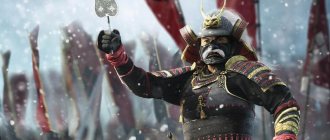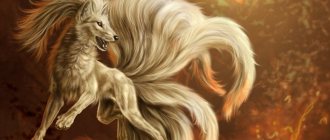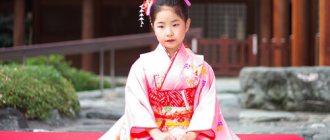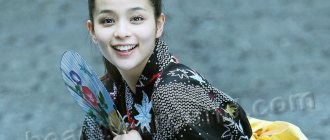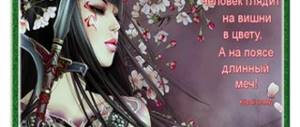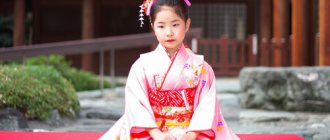New Year is loved in Japan as much as in the rest of the world. It is not surprising that the inhabitants of the Land of the Rising Sun have their own attributes of this holiday, including their own Santa Claus. More precisely, there are even two of them.
How did this happen? Everything is very simple, the traditional symbol of the New Year holidays is Segatsu-san, and after the penetration of Western culture into the country, its own version of Santa Claus appeared here - Oji-san. Below is more detailed information about each of them.
All-seeing and all-knowing
The name of the oldest Japanese Santa Claus is Hoteyosho. This is the main symbol of the New Year. He knows people's weaknesses and desires, and can interfere with fate at the moment when the year begins “with a clean slate.” This is why the Japanese revere him as a god and worship him, expecting fulfillment of wishes, good luck and prosperity. Japanese Santa Claus in the guise of the god Hoteyosho is portrayed as a good-natured old man who has eyes not only on his face, but also on the back of his head.
Oji-san
Oji-san is a relatively young character. The influence of the world has not bypassed the holidays of Japan and this is a prime example of this. The prototype of the hero is the American Santa Claus. Of course, the Japanese patron of the holiday and the favorite of American children are different magicians, but they have a lot in common. It so happened that the popularity of the borrowed wizard is gradually growing to the detriment of the love for Segatsu-san, because the new character not only congratulates people, but also gives gifts to children. He appears in Japan for one night only. Legends say that a wizard arrives from across the sea.
Oji-san appeared in Japanese traditions at the end of the last century. His appearance corresponds to the American prototype: grandfather is dressed in a red sheepskin coat and looks good-natured and happy. Recently, children are increasingly writing letters to him. Dressing up as Oji-san has become popular - in schools and shopping centers when the New Year approaches, you can see people dressed up as a fairy-tale character. In many ways, this is a tribute to tourism, since Christmas is a season of high travel activity.
Japanese Santa Claus
This is interesting
Japan has its own real Santa Claus. His real name is Paradise Yamamoto. A native of Hokkaido passed the exam in 1998 and received the status of an official Santa - the first in Asia. Later, the 1st World Santa Claus Congress was even organized in Japan.
Japanese New Year characters
Mister January doesn't like fuss
The successor of Hoteyosho in Japan is considered to be a character whose presence at the holiday is more noticeable because he goes from house to house on the eve of the celebration. This is Segatsu-san. The wizard's name comes from the name of the month that begins the year - January, which sounds "segatsu" in Japanese. The particle “san” in the name of the Japanese Santa Claus means a polite form of address, which can be translated as “mister.”
Segatsu-san does not like fuss, and therefore he slowly goes from house to house for the whole week, and not just on New Year's Eve. He congratulates the inhabitants of the houses on the New Year, but does not give gifts. This is one of the main differences between the Eastern New Year's grandfather and his Western colleagues. Another difference is what Japanese Santa Claus looks like. He is dressed, of course, not in a fur coat, but in a kimono, and the color of the outfit is “ao”, in Japanese this word refers to two shades - blue and green.
Japanese Santa Claus
Over the past 10 years, the name Segatsu-san has begun to appear in texts dedicated to the traditions of New Year celebrations in different countries. As indicated in the “directories of Santa Claus’s colleagues”, in accordance with the territorial characteristic, “Mr. January” (or as he is also called “Mr. New Year”) is in charge of New Year’s miracles in Japan. You can also read that traditionally it is an elderly person dressed in a turquoise-colored kimono who travels around the country a week before the new year, it is also called “golden”. He does not have a magic bag with him, does not give any gifts, but only greets the residents and congratulates them “on the upcoming year,” moreover, his name comes from the name of the first month of the year, that is, January. Everyone is carefully preparing for the meeting with the venerable old man... but is it really him they are waiting for?
According to tradition, the Japanese decorate their homes with kadomatsu, mochibana and kagami-mochi to welcome the New Year deity Tosigami. The name of God fully reflects his essence, since “toshi” (年) is translated as “year”, and “kami” (神) is “deity”. It is to him that people turn to him with requests for good luck and protection from troubles in the coming year, and also ask for his divine blessing for the year ahead.
The origin of the name “Segatsu-san” is related to the naming of the beginning of a new year, since “shogatsu” (正月, Shōgatsu) is translated as “new year’s day” or “new year”, and “san” (さん) should be translated as neutral polite a suffix that is added when addressing a person. In fact, it turns out that the Japanese greet the “New Year’s gentleman” and wait for his appearance, but at the same time all the preparations are similar to those that greet Toshigami - the decorations and treats are the same.
Thus, we can assume that Toshigami and Segatsu-san may well be the same character, because in fact they:
- visit Japanese houses on the eve of or on the eve of a holiday;
- don't give gifts;
- they look like a venerable old man with a long white beard (at least a long-bearded venerable gentleman is one of the typical images of the divine essence);
- they do not perform any miracles and do not fulfill wishes, but only bless.
What about January? The name of the months in Japanese is based on the principle of combining the ordinal numbers 1, 2, 3, etc. with the word “month” (月, Tsuki, read as “ski”). Despite the visual similarity in hieroglyphs, “New Year's Day” is not identically equal to January. Moreover, the name of the month has nothing to do with it at all, otherwise Mr. Segatsu-san would have to patronize the entire month, and not just its beginning.
However, there is one curious point: if we appeal only to the writing of the name in hieroglyphs, it should be borne in mind that there is no difference between Japanese and Chinese characters, since kanji were borrowed from the Chinese language. If we compare the translation of 正月 (Shōgatsu) from Japanese and Chinese, respectively, it turns out that in Japan this is what they call “New Year”, and in China it is “the first month”. Here it is January.
“Golden Week” in Japan is a series of spring public holidays that begins on April 29 with Showa Day. Initially, the Emperor's Birthday was celebrated on April 29, but after the death of Hirohito (Emperor Showa), the holiday was renamed Greenery Day, and starting in 2007, the name “Showa Day” was officially adopted. The holiday was established in honor of the memory of the reign of Emperor Hirohito.
Holidays that make up “Golden Week”:
- April 29 - Showa Day
- May 3 - Japanese Constitution Day
- May 4 – Green Day
- May 5th - Children's Day
Happy New Year and “Golden Week”, when Segatsu-san goes from house to house and congratulates residents, the real “Golden Week” has nothing in common.
To begin with, you should understand that Santa Claus largely “borrowed” his magical abilities from the Greek Archbishop Saint Nicholas, and also took an example from the character of British folklore “Father” or “Spirit” of Christmas (Father Christmas) - his love of celebration and fun has British roots. The first time Santa's name was recorded in the American press was on December 23, 1773, in the Rivington's Gazette (New York City) newspaper. We can safely say that over the course of his 247 years, Santa Claus has become a truly legendary figure.
Christian (Catholic) Christmas in Japan has been celebrated since the 16th century, but since 1854, under the influence of Western American culture, it began to be truly celebrated. Until 1912, Christmas in Japan was called the “Holy Birth Festival” (聖誕祭), which sounded like “Seitansai”, but later the name was adapted to English and became “Kurisumasu”.
Obviously, with this order of things in Japan, they simply could not help but know about Santa Claus. By the way, this is a rather remarkable fact - little Japanese love to write letters to Santa and wait for his appearance on Christmas Eve. According to statistics maintained by the Santa Claus Postal Service (postal code FIN-96930), Japan is among the top three countries that send the most letters to the good-natured uncle, after the UK and Poland.
By the way, if we again engage in linguistic analysis and look at how Santa is called in Japan (again, in accordance with various notes that are in the public domain), then “Oji-san” is actually just “uncle” or a man aged 40-50 years. おじ さん (Oji-san) is not a proper noun.
Pre-war postcard, probably dated 1914.
Another interesting fact is related to how Japanese culture “adapted” to Western canons. Typical Japanese houses do not have fireplaces, so as an alternative to Santa's entry into the home, the Japanese came up with the story that he climbs inside through a window or simply materializes in the house. Santa Claus leaves gifts not under the tree, which often may not exist, but at the head of the bed next to the pillow.
History of Japanese Christmas
Christianity is not the leading religious movement in Japan, but everyone celebrates the holiday - how is that possible? If we touch on the meaning of Christmas, then we should emphasize that Kurisumasu Eve is a celebration that can be celebrated with family, friends or lovers. It is on December 24-25 that it is customary to exchange gifts and have fun, walk along beautifully illuminated streets and meet people dressed in Santa Claus costumes (and sometimes his reindeer). The older generation of Japanese expresses respect to each other, the younger generation enjoys life and romanticizes the holiday, and children wait for gifts from Santa, which he will take out of his bag .
The traditions of preparing for Christmas were also adopted from the West and are very much loved by the Japanese - so much so that they even prepare (or buy) a festive sponge cake, generously decorated with whipped cream and strawberries, which they proudly call “Kurisumasu-keki” (Christmas cake).
The seven deities, who bring good luck and are also willing to generously share their treasures with all who believe in them, sail through the skies on their mythical ship called Takarabune on the first 3 days of the new year. The period from January 1 to January 3 also has its own name - 正月三が日 ( Shōgatsu san ganichi). An image of a ship, be it a figurine, figurine or engraving, can also be classified as a traditional New Year's decoration, but there is a nuance.
There is a custom akin to fortune telling - on the night of January 1-2, placing an image of Takarabune under the pillow (originally such were engravings). If the dream is calm and happy, it means that everything will be successful and good in the coming year, but if the dream is restless or unpleasant, you can always “refuse” it by letting the image of a ship float down the river.
One of the seven gods is Jurojin, the god of longevity. He is often depicted as an elderly man with a long gray beard, wearing a blue, turquoise or white kimono and a traditional headdress. One of his attributes is a staff. As you know, Santa Claus also uses a magic staff. The following assumption may not be true, however, apparently, due to the presence of a staff in both characters, they are called colleagues - after all, it is this image of Jurojin that is mistakenly passed off as a portrait of Segatsu-san.
There can be no doubt, because next to the “Japanese Santa Claus” stand Daikoku, Ebisu and Bishamonten - the gods of happiness, sailing with him on Takarabune.
Hotei, another god of happiness, is also sometimes included in the ranks of Japanese winter wizards. The deity of fun and wealth is often depicted surrounded by children, and he also has a bag in which, according to legend, “the whole world” is kept. To form the image of a colleague of Santa Claus, all of the above fits perfectly into the concept, and the fact that Hotei’s appearance in the sky occurs at the beginning of the new year counts towards the overall “characteristics” of Santa or Father Frost. Essentially, this is just a generalization that goes in the wrong direction.
All the Seven Gods of Fortune are sailing on the same ship on New Year's Eve, so considering one of them a colleague of the winter wonderworkers is not a good idea.
Despite the inconsistencies in the overall story with the character whose name sounds like Segatsu-san, it is worth recognizing that he is still a colleague of Father Frost, like Santa Claus. The thing is that over the past ten years this name has been heard most often when mentioning winter sorcerers, so it has already become sufficiently ingrained in people’s consciousness. This is how history is made. Once people begin to believe in something or someone, the creed gains power. In any case, the issue of faith in other beings is periodically raised in the anime and is revealed in exactly this way.
Unfortunately, not a single original Japanese engraving, drawing, description, or even direct mention of one character was found who works miracles, congratulates on the New Year or Christmas, gives gifts and makes wishes come true.
However, there is a photograph of the figurine! But even here there was an explanation. This is an original work, a fantasy about what a Japanese Santa could be like. The original composition is called “Japan Father Snow” and was created in 2008.
Segatsu-san is a modern collective image of all those deities that the Japanese honor and whose appearance is expected every new year.
It is worth noting that everything described in the article may turn out to be a mistake, but to make sure of this, you first need to go to Japan and ask the local residents - but still, who is Segatsu-san?
What do the Japanese do a week before the New Year?
On the days when Segatsu-san visits houses, residents diligently prepare for the celebrations. There are bazaars, fairs, and shops where you can buy gifts: talismans, souvenirs, amulets. Ritual items are warmly welcomed when celebrating the New Year. Hamaim (arrows with white feathers) protect the house from unclean spirits, and boats filled with rice promise wealth. The most popular and even obligatory New Year's gift in Japan is kumade, translated as a “bear paw” made of bamboo, similar to a rake for rowing happiness.
They meet the Japanese Santa Claus at the entrance to the house, in a bamboo gate entwined with pine branches, symbolizing longevity, or pull a rope made of rice straw, decorated with fern leaves and tangerines. In wealthy houses during celebrations you can see dwarf pines, peach and plum trees in bloom. Segatsu-san will be happy if the children show him a show or build snow figures on the porch.
Video: how New Year is celebrated in different countries
May you also be lucky enough to plunge into adventure and go on a trip this New Year!
Elena Rudnik
This is interesting!
5 museums of illusions: optical illusion on a grand scale 05/01/2017 6447
10 secrets revealed by memory: development of abilities 06/07/2017 2862
An aphrodisiac from Mother Nature called Durian 11/07/2017 3912
Wishes and gifts
Japanese Santa Claus wishes people longevity and good luck and will not forget to remind them to put pictures of sailboats under their pillow on New Year's Eve so that they will be blessed by the seven gods, each of whom “manages” his own virtue: Daikoku gives luck, Jurojin gives longevity , Benton - friendliness, Ebisu - sincerity, Hotei - generosity, Bishamon-ten - dignity, Fukurokuju - benevolence. It is believed that the seven gods sail to the shores of Japan on a ship along with “Mr. January”, who lives on the island of Honshu.
Segatsu-san gives people only congratulations and good wishes, but material gifts are presented by older family members to younger ones. Peers the same age do not give each other gifts. The main gift is “otoshidama”, that is, “treasure of the year”. These are bright envelopes with money decorated with a bow.
Hoteisho
The Japanese deity Hoteisho is not at all similar to European ideas about New Year's wizards. It sees everything in the world - for this, God has eyes in the back of his head. For the Japanese, Hoteisho is the main New Year's symbol, an object of worship. People turn to him with requests to bestow good luck and happiness. Hoteisho has been known longer than other New Year's sorcerers, but recently his popularity has dropped noticeably, because the deity does not give gifts, does not go from house to house, and does not wear beautiful outfits. But in the past, Hoteisho was the main character of the winter holidays.
Hoteisho - an ancient Japanese deity
Eastern Santa
Recently, the kids of the Land of the Rising Sun are well aware of the name of the Japanese Santa Claus: Oji-san. This is exactly the same old man with a bag of toys on his back, familiar to all the children of the world. This Japanese Santa Claus gives gifts to boys and girls who have earned them by good behavior throughout the year.
The word "Oji-san" in Japan is used as a respectful way of addressing an old person. This character appeared relatively recently as a tribute to Western tradition. The costume of the Japanese Father Frost Oji-san also resembles the attire of Santa Claus: a red sheepskin coat trimmed with white fur, boots and a pointed hat with a bomb. Like Santa, Oji-san appears on the night from December 31 to January 1 and gives children and adults an exciting holiday atmosphere. He enters when the copper bell rings, signaling the transition from the old to the new year. The bell rings 108 times, thus performing a ritual of cleansing from all vices.
Segatsu-san
This wizard is named after the first month of the year. Segatsu-san is unlike Western Christmas and New Year wizards. He wears a green kimono, but sometimes chooses clothes of other colors. The sorcerer's head is adorned with a traditional headdress, and his beard is so long that it sweeps the floor. Santa Claus “works” not at night, as is customary all over the world, but at seven. The Japanese called them "golden". They begin to prepare for a long holiday in advance - at least half a month in advance. However, although the character goes around the house, he does not give gifts - this remains the responsibility of the parents. The task of the magical old man is to visit a Japanese house and congratulate the inhabitants on the advent of a new period.
Celebrating the New Year for residents of the Land of the Rising Sun is a responsible task. They prepare for it, trying to make the house look attractive to the magician: they make bamboo gates, install dwarf pine trees, decorated with peach blossoms at the entrance doors. In honor of the New Year, children are given new outfits - a symbol of health and prosperity.
While waiting for Segatsu-san to arrive, the household plays hanetsuki, performs in small productions, and sculpts snow characters and houses. A popular pastime is kite flying. On New Year's Eve, a drawing of a boat is always placed under the pillow - a symbol of happiness, luring the Seven Gods arriving with Santa Claus on a magical ship from Honshu, where New Year's grandfather's house is located in Shiogama.
Santa Claus in a green kimono
Joulupukki Finland
Still the same Santa Claus, only Finnish . For transport, he uses a cart pulled by a goat. That's why they call him "Youlupukki" . After all, from Finnish it means “Christmas goat” .
You can recognize him among the crowd by his cone-shaped hat and short fur coat. The gnomes help him. And Joulupukki himself is not much different from these cute little creatures. Finnish Santa Claus lives on Mount Korvaptupturi with his wife Muori. Grandfather's special feature is that he has excellent hearing. He knows everything that children want, even if they say it in a whisper.
Santa Claus
United States of America, Canada and Australia. Who doesn't know the chubby old man from the Coca-Cola commercial? Unlike Father Frost, Santa Claus wears a short jacket and red pants . His glasses and red cap never change and never disappear.
Santa has a constant tradition of laughing in a friendly manner, like “Ho-Ho-Ho!” , and say: “Merry Christmas everyone!” . He lives in Lapland with his assistants, the Elves. Together they make gifts for the children, and then place them under the trees or in stockings hanging over the fireplace. Santa moves across the sky on a sleigh pulled by reindeer. This old man enters the house through the chimney.

